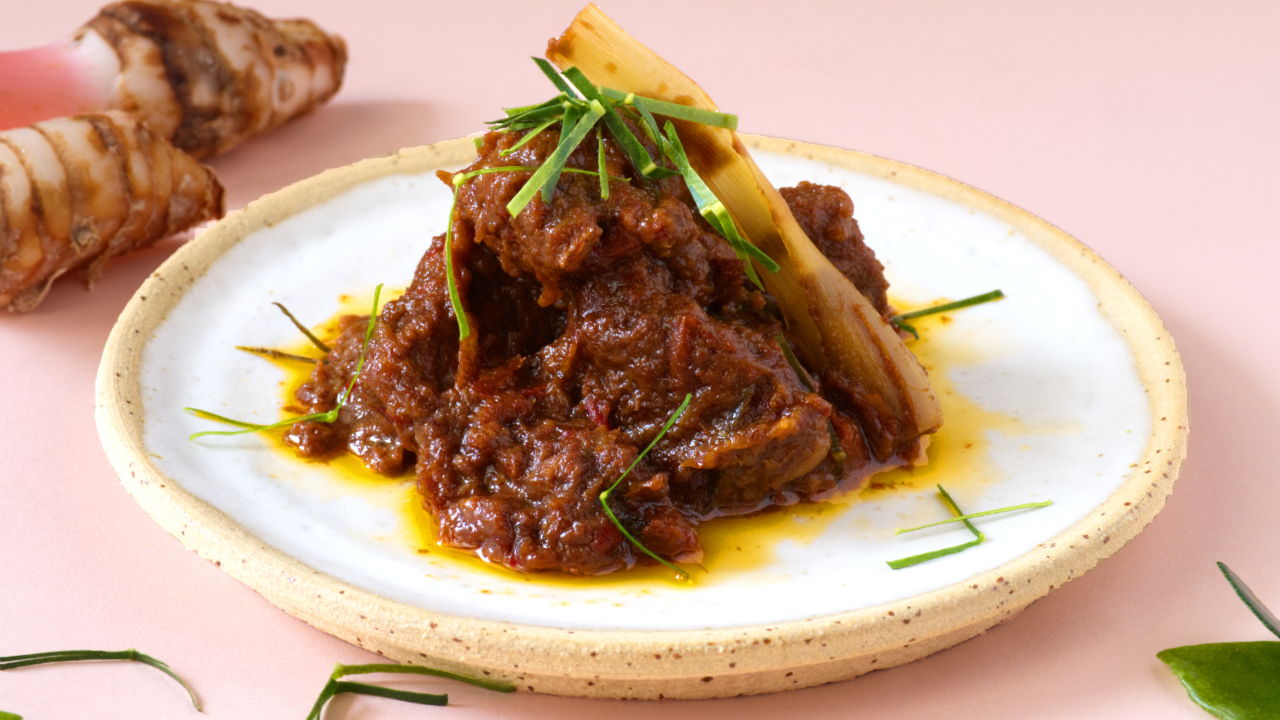Rendang is a very special curry dish. Made with a selection of 10 different types of spices such as chillies, turmeric, lemongrass and galangal, it easily stands out for its awesome flavour which develops over the long and slow cooking process.
It's so tasty that it was voted as the most delicious food in the world based on 35,000 votes in a survey carried out by CNN. The complexity of the dish and the details that come along with it made rendang an exclusive dish.
It's usually served for weddings, religious celebrations and coronation ceremonies. Now that we know rendang is the king of curries and tastes extremely delicious, it is important to understand the dish and the tips to achieve the best result.
Who Invented Beef Rendang?
Rendang originates from the Minangkabau ethnic from West Sumatra. With the migration of Minangkabau immigrants to its neighbouring countries such as Singapore and Malaysia, it was then introduced to other neighbouring countries such as Malaysia and Singapore.
The name ‘rendang’ came from the Sumatran word ‘randang’ which means slowly. This clearly refers to the cooking process which takes a long time. Traditionally, it takes between 8 hours to 3 days to cook rendang! Some suggested that the correct name for the dish should be the latter instead of what it is known today.
How Does Rendang Taste Like?
Rendang does not tastes like the red curries from Thailand or India. Instead, it is thick and has a texture almost like soft butter. The flavour of rendang stems from the mixture of spices that blend in harmoniously, giving it a touch of heat that comes through subtly when eaten.
The sensation of smell and taste of rendang is simply divine. Besides that, the aroma from the spices and the nutty flavour of ‘kerisik’ which is also known as coconut butter make the dish stands out from the other types of curries.
Kerisik is made of grated coconut which has been toasted until golden brown before being pounded until its oil is released. It is usually added to dishes and stewed for hours for all the ingredients to release their optimum flavours.
Why Does It Take So Long to Cook Rendang?
The initial intention when making rendang was to prepare a dish that would keep for a long period without the help of refrigerators. Cooking for a long time ensures that any excess liquid will be evaporated.
Hence, allowing the dish to last longer. It also takes at least 2 hours 30 minutes (portion for 4-6 persons) for the coconut milk to begin caramelizing. So, be patient for the perfect colour and texture of the curry to emerge.
The Best Malaysian Style Beef Rendang Tips
Here comes all the kampung secrets to making the best tasting rendang!
When sautéing the pounded or blended spices, you'll need to follow the steps recommended in the recipe as different spices or herbs need different amount of time to be cooked until it's fragrant. The sequence to sauteing the ingredients is lemon grass first followed by garlic-onion-ginger mixture then, galangal and lastly, shallots.
During the long cooking process, the sugar in the coconut milk caramelizes as the liquid is reduced. Subsequently, another crucial step which cannot be skipped is to sauté the meat until excess water is evaporated before adding the coconut milk. This will help to intensify the flavour besides reducing the excess liquid.
Can I Use Chicken to Make Rendang?
The original choice of meat for rendang is beef. Compared to chicken, beef is able to sustain the slow cooking process. Theoretically, chicken can be used but the meat would break down during the long cooking process.
There will be lots of small chunks of chicken with strands of the protein in the pot at the end of cooking. That's why chicken rendang takes a shorter time to cook. Hence, the gravy wouldn't be as caramalized when compared to beef rendang.
However, unlike chicken, beef is able to handle the heat while retaining its shape. Therefore, the meat coated with the thick gravy is a delight to savour in every mouthful.
Which Part of Beef Is Good for Rendang?
The cheapest cut of meat! Ask for beef meant for stew. Softer cuts of beef may risk turning out tough after the long cooking process. Beef used for stew is usually from the shoulder and upper arm muscles of a cow and sometimes labeled as chunk.
Type of Chillies Used
I used a combination of dried and fresh chillies. The dried chillies are used for its smoky flavour while fresh chillies gives a nice shade of redness to the curry. You may opt for either type if you're unable to get both.
As for dried chillies, I used the Sri Lankan dried chillies as they are the only type available at the Asian grocer I used to frequent. Dried chillies of the types Byadgi or Kashmiri would work equally good too. To learn more about reducing the spiciness of dried chillies, tips on substitutes or where to buy them, check out this page about dried chillies.
For fresh chillies, cayenne peppers is the best choice for its size and also level of spiciness.
If you are not at all used to spice and heat, use long red paprika. They are also known as Boldog paprika. This might be offensive to rendang lovers but it's a great substitute to introduce rendang to non-spicy eaters. If Boldog paprika is used, do sauté them until it is fragrant and ensure that most liquid from the paprika is evaporated.
Pound, Blend or Chop the Herbs?
While blending is the easiest out of the other 2 processes, pounding gives the best flavour as oil from the spices and herbs are released.
If you choose to chop the herbs, do ensure that they are chopped finely as the long stewing process may not be able to soften ingredients like galangal and lemongrass. Biting into any of these herbs might be unpleasant. If you don't choose to mince the lemongrass, leave it as it is as it can be removed after cooking.
How Long Does Beef Rendang Last?
If cooked properly and excess water is removed according to the recommended steps, rendang can be kept at room temperature for up to 3 weeks. However, this recipe does not cater for such long storage.
It's best to cool the dish to room temperature before refrigerating it for up to 5 days. You may freeze the dish in an airtight container for up to 3 months.
How to Reheat Rendang?
You maybe use the microwave to reheat the dish. Frozen rendang should be thawed before reheating. If you do not have a microwave, steam the dish for at least 40 minutes to ensure that it is fully heated.
Cooking Rendang in a Slow Cooker
You may cook beef rendang using a slow cooker. Simply put all the blended ingredients, meat, coconut milk and water into the slow cooker and cook for 12 hours. The beef rendang will be very tender.

